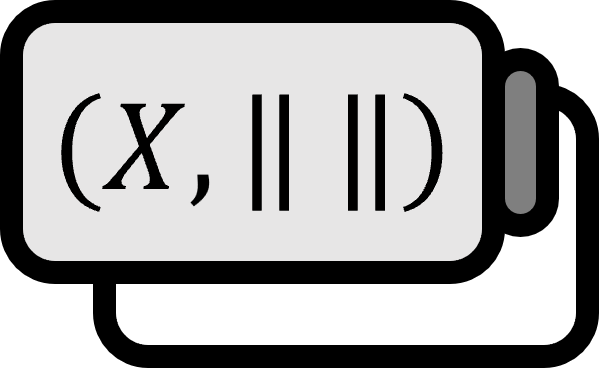Extensions of Bounded Linear Operators
Theorem1 2
Let $V_{1}, V_{2}$ be a Banach space. Let $W \subset V_{1}$ be a dense subspace. And let $T : W \to V_{2}$ be a bounded linear operator. Then for all $\mathbf{v} \in W$, there exists a unique bounded linear operator that satisfies
$$ \widetilde{T} : V_{1} \to V_{2} $$.
Moreover, the following holds:
$$ \| \widetilde{T} \| = \left\| T \right\| $$.
Explanation
$\widetilde{T}$ is called the extension of $T$.
 Although it is not specified what $\widetilde{T}$ looks like in the theorem, it is basically defined through the convergence of sequences in dense subspaces during the proof process. By extending this way, the operator $\widetilde{T}$ can be naturally denoted as $T$.
Although it is not specified what $\widetilde{T}$ looks like in the theorem, it is basically defined through the convergence of sequences in dense subspaces during the proof process. By extending this way, the operator $\widetilde{T}$ can be naturally denoted as $T$.
When there are bounded linear operators $T : W \to V$ and $\mathbf{w} \in \overline{W}\setminus W$, we wish to define $T \mathbf{w}$, but since the domain of $T$ is limited to $W$, it’s not possible. However, the sequence $\left\{ \mathbf{w}_{k} \right\}$ converging to $\mathbf{w}$ exists within $W$, so $T \mathbf{w}$ can be ‘indirectly’ defined in the following plausible manner:
$$ T (\mathbf{w}) := \lim \limits_{k \to \infty} T(\mathbf{w}_{k}) $$
To paraphrase,
Since $\mathbf{w}$ is originally not part of the domain of $T$, $T \mathbf{w}$ cannot be defined. However, there exists a sequence $\left\{ \mathbf{w}_{k} \right\}$ that converges to $\mathbf{w}$ within the domain of $T$. Therefore, when $\mathbf{w}_{k} \to \mathbf{w}$, it will be $T \mathbf{w}_{k} \to T \mathbf{w}$, so defining it like $T \mathbf{w} := \lim\limits_{k\to \infty}T \mathbf{w}_{k}$ is natural and plausible. And this is indeed possible.
Thus, it is guaranteed from the above theorem that a bounded linear operator $T : W \to V$ defined on a Banach space $W$ can expand its domain in the same way up to the closure $\overline{W}$ of $W$ while maintaining the mapping to $V$.
Proof
Let’s denote by $\mathbf{v} \in V_{1}$. Assuming that $W$ is dense in $V_{1}$, there exists a sequence $\left\{ \mathbf{v}_{k} \right\}$ that converges to $\mathbf{v}$.
$$ \lim \limits_{k \to \infty} \mathbf{v}_{k} = \mathbf{v} $$
Since $T$ is bounded and linear, the following holds for $\ell, k \in \N$:
$$ \left\| T \mathbf{v}_{k} - T \mathbf{v}_{\ell} \right\| = \left\| T (\mathbf{v}_{k} - \mathbf{v}_{\ell}) \right\| \le \left\| T \right\| \left\| \mathbf{v}_{k} - \mathbf{v}_{\ell} \right\| $$
Now, since $\left\{ \mathbf{v}_{k} \right\}$ is a Cauchy sequence, by the above equation, $\left\{ T \mathbf{v}_{k} \right\}$ also becomes a Cauchy sequence. Therefore, since $V_{2}$ is a Banach space, $\left\{ T \mathbf{v}_{k} \right\}$ will converge to some element within $V_{2}$. From this, define $\widetilde{T}$ as follows:
$$ \widetilde{T} \mathbf{v} := \lim \limits_{k \to \infty} T\mathbf{v}_{k} $$
Then, due to the properties of the bounded linear operator for all $\mathbf{v} \in W$, $T \mathbf{v}_{k} \to T \mathbf{v}$ holds, thus satisfying $\widetilde{T} \mathbf{v} = T \mathbf{v}$. Now, consider the case of $\mathbf{v} \in V_{1}\setminus W$.
Part 1. The irrelevance of sequence choice
Consider two sequences $\left\{ \mathbf{v}_{k} \right\}, \left\{ \mathbf{u}_{k} \right\}$ of $W$ that converge to $\mathbf{v}$. If $\mathbf{v}$ were an element within $W$, since $T$ is a bounded linear operator, when $\mathbf{v}_{k}, \mathbf{u}_{k} \to \mathbf{v} \in W$, $T \mathbf{v}_{k}$ and $T \mathbf{u}_{k}$ would converge to the same value $T \mathbf{v}$. However, in the case of $\mathbf{v}_{k}, \mathbf{u}_{k} \to \mathbf{v} \in V_{1}\setminus W$, this property cannot be used, so it must be directly confirmed whether they converge to the same value.
Now consider the following sequence $\left\{ \mathbf{w}_{k} \right\}$:
$$ \left\{ \mathbf{w}_{k} \right\} = \left\{ \mathbf{v}_{1}, \mathbf{u}_{1}, \mathbf{v}_{2}, \mathbf{u}_{2}, \dots \right\} $$
Then $\lim \limits_{k \to \infty} \mathbf{w}_{k} = \mathbf{v}$ holds, and $T \mathbf{w}_{k}$ also converges to some value $\widetilde{T} \mathbf{v} = \lim \limits_{k \to \infty} T\mathbf{w}_{k}$. Since $T \mathbf{v}_{k}$ and $T \mathbf{u}_{k}$ are subsequences of $T\mathbf{w}_{k}$, they both must have the same limit value. Therefore, regardless of which sequence converging to $\mathbf{v}$ is taken, $\widetilde{T} \mathbf{v}$ is uniquely determined.
Part 2. Linearity
Let $\mathbf{v}, \mathbf{w} \in V_{1}$ and suppose $\mathbf{v}_{k} \to \mathbf{v}, \mathbf{w}_{k} \to \mathbf{w}$.
$$ \begin{align*} \widetilde{T} \left( \alpha \mathbf{v} + \beta \mathbf{w} \right) =&\ \lim \limits_{k \to \infty} T \left( \alpha \mathbf{v}_{k} + \beta \mathbf{w}_{k} \right) \\ =&\ \alpha \lim \limits_{k \to \infty} T ( \mathbf{v}_{k} ) + \beta \lim \limits_{k \to \infty} T ( \mathbf{w}_{k} ) \\ =&\ \alpha \widetilde{T} \left(\mathbf{v}\right) + \beta \widetilde{T} \left(\mathbf{w} \right) \end{align*} $$
Part 3. Bound, $\| \widetilde{T} \| = \left\| T \right\|$
Let’s denote by $\mathbf{v} \in V_{1}$ and suppose $\mathbf{v}_{k} \to \mathbf{v}$. Since the norm is continuous, limits can be interchanged. Using this fact and the boundedness of $T$,
$$ \begin{align*} \left\| \widetilde{T} \mathbf{v} \right\| =&\ \left\| \lim \limits_{k \to \infty} T \mathbf{v}_{k} \right\| \\ =&\ \lim \limits_{k \to \infty} \left\| T \mathbf{v}_{k} \right\| \\ \le& \lim \limits_{k \to \infty} \left\| T \right\| \left\| \mathbf{v}_{k} \right\| \\ =&\ \left\| T \right\| \left\| \lim \limits_{k \to \infty} \mathbf{v}_{k} \right\| \\ =&\ \left\| T \right\| \left\| \mathbf{v} \right\| \end{align*} $$
Therefore, $\widetilde{T}$ is bounded, and $\| \widetilde{T} \| \le \left\| T \right\|$ is valid. Now let’s show that the opposite inequality holds. For vectors that are $\mathbf{v} \in W$, the following holds:
$$ \| \widetilde{T} \mathbf{v} \| = \| T \mathbf{v} \| \le \| T \| \| \mathbf{v} \| $$
However, for vectors that are $\mathbf{v} \in V_{1} \setminus W$, there can be vectors that are not bound as above by $\| T \|$. Hence, the validity of $\| \widetilde{T} \| \ge \left\| T \right\|$ can be known. Therefore, since both sides of the inequality hold, we obtain:
$$\| \widetilde{T} \| = \left\| T \right\|$$
■
